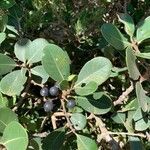Spreading much-branched evergreen shrub or small tree; height up to 15m.; older branches glabrous; bark grey and fissured.. Petiole 0.5–1.5(–2) cm. long, glabrous.. Leaf-lamina elliptic, elliptic-obovate to obovate, (3-)4–10(–15) cm. long, (l.5-)2–6(–7.5) cm. wide, apex obtuse to rounded or emarginate, base tapering, narrowly cuneate and decurrent with petiole, glabrous on older leaves; upper surface with slightly raised nervation, lower surface with lateral nerves slightly raised and inconspicuous.. Pedicels up to 7 mm. long, puberulous.. Sepals broadly ovate, up to 2.5 mm. long, puberu-lous or ± glabrescent outside.. Corolla greenish-white; tube up to 1.5 mm. long; lobes ± ovate, up to 2.5 mm. long.. Filaments 1.5–4 mm. long.. Staminodes petaloid, ± ovate, but sometimes constricted near base, 1.5–3 mm. long, irregularly serrulate or rarely ± entire.. Ovary subglobose; style short, up to 1.5 mm. long.. Fruits green at first but finally ripening black, 6–15 mm. in diameter.. Seeds solitary, depressed subglobose, 4–9 mm. in diameter, with 1–5 longitudinal ridges and with 1–4 small pits (impressions of aborted ovules) near the larger basal scar; embryo horizontal, with lateral radicle.
Tree or shrub, 1-15 m high; blackish bark. Leaves dark green, glossy above, elliptic to obovate, base acuminate, apex slightly acute, glabrous above. Flowers 5-merous throughout, scented, axillary. Corolla 5-lobed, without lateral appendages, campanulate, whitish green, ovate, auricled at base. Calyx up to 2 mm long, cup-shaped, imbricate glabrous. Stamens arising from throat of corolla tube; staminodes petaloid, with a broad base, alternipetalous. Ovary with basally attached seed. Flowering time all year. Fruit 1-seeded, up to 100 mm in diam., purple to blackish. Seeds depressed-globose, with small, circular scar in a basal depression; testa thick, bony, dark brown.
A small evergreen tree. It is often crooked and low but can be straight and up to 11 m tall. The bark becomes cracked with age. The leaves are tough and leathery and dark green above and paler beneath. They are 2.5-12 cm long by 1.5-5 cm wide. They are oval. The midrib is easy to see and raised underneath the leaf. The young leaf stalks are covered with rusty red hairs. The flowers are small and green. They occur singly or in clusters in the axils of leaves. The flowers have a strong unpleasant smell. The fruit are small and round. They can be 1.2 cm across. They are purplish black when mature. There is one seed inside.
Leaf lamina 3·5–9·5 x 2–4·5 cm., elliptic to obovate, sometimes elliptic–ovate or suborbicular, the apex rounded, slightly emarginate or acute, the base cuspidate to acuminate; petiole 0·5–2 cm. long. Upper leaf surface glabrous, midrib level with surface. Lower surface often ferrugineous–pubescent, glabrescent; midrib fairly prominent, lateral nerves indistinct, tertiary veins forming a fine even reticulation.
Shrub or small tree to 10 m with white latex. Leaves dark green, leathery, elliptic, obtuse. Flowers 1-few in axillary clusters or cauliflorous, greenish white. Fruits fleshy, black.
Apical buds ferrugineous pubescent; distal leafy part of branchlets pubescent or glabrous; older leafless twigs with grey striated bark.
Corolla 2·4–3·6 mm. long, campanulate, whitish, cream–coloured or greenish; lobes 2–3 times as long as tube, ovate, auricled at base.
Flowers 4– or 5–merous, scented, in few– to many–flowered fascicles in leaf axils or on older wood; pedicels 0–4 mm. long.
Calyx 1·6–2 mm. long, cup–shaped; lobes suborbicular, imbricate, ± glabrous.
Evergreen shrub or small tree 2–15 m. tall with brown or blackish bark.
Seed up to 6 mm. in diameter, glossy, cream–coloured or dark brown.
Fruit up to 1 cm. in diameter, purple to blackish.
Staminodes c. 1·8 mm. long.
Anthers 1–1·4 mm. long.

